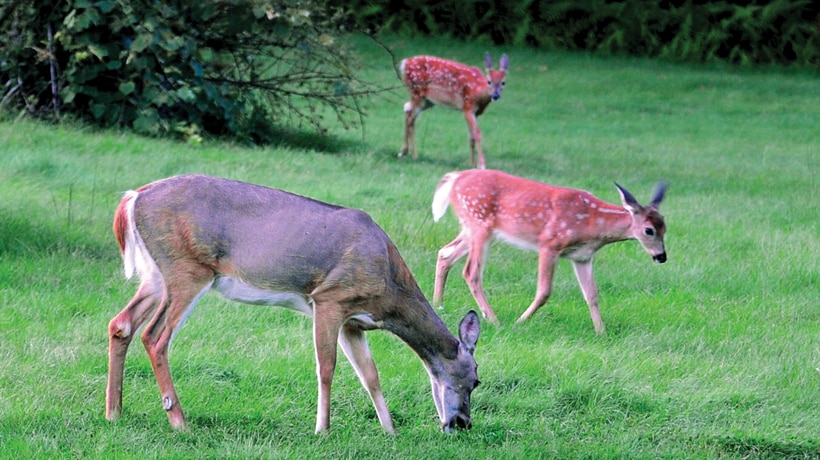Deer in Massachusetts
White-tailed deer are found throughout Massachusetts. They are an important and valuable wildlife species in Massachusetts for which a regulated hunting season (fall/winter) and management program have been established.
Description
White-tailed deer can reach a total length of approximately 6 feet and a height of approximately 3 feet at the shoulder. Weight depends on age, sex, and physical condition, but adult males (bucks) weigh an average of 120–160 pounds, while females (does) average 80–120 pounds. Bucks have antlers made of bone that grow each spring and summer and are shed after the breeding season in late winter.
During the summer, the upper coat of the deer is reddish-brown with short, thin, straight, wiry hairs. In winter, the coat changes to a grayish-brown, with long, thick, hollow hairs that are slightly crinkled and provide excellent insulation against the cold. The belly, the throat, the areas around the eyes, the insides of the ears, and the underside of the tail are white year-round. Fawns are chestnut-brown with conspicuous white spots on their back and sides that provide camouflage from predators. These spots fade by 3–4 months of age.
Deer can run 40 mph for short bursts and maintain speeds of 25 mph for longer periods. They are excellent at jumping; capable of clearing obstacles up to 9 feet high or 25 feet wide. A deer’s visual acuity is great at any time of day and their eyes are impressive motion detectors. They have dichromatic vision and can distinguish among most colors (except in the red/orange spectrum). Because their eyes are on the side of their head, they don’t have the best depth-perception, but it appears they can gauge distance by moving their head. Their keen senses of smell and hearing help them detect danger.
Life history
White-tailed deer are crepuscular (most active at dawn and dusk) and tend to be more active at night than during the day, often venturing into areas they would avoid during the day, like backyards. Deer can live over 10 years in the wild, with females typically living longer than males.
Most females do not breed until they are 1.5 years old. After a gestation period of about 28 weeks, fawns are born, sometime between late May and early July. Depending on age and physical condition, a doe may produce one to three fawns, but the average is two, each weighing about 4–6 pounds and able to walk within an hour of birth. Typically, an adult doe, her fawns, and in some cases female offspring from the previous year will all stay together on the maternal range, in a familiar habitat from 0.5 to 2 square miles in size. Most males will leave the maternal range as a 1–1.5 year old (yearling) to establish a new home range, which is called a dispersal. Dispersal is an evolved response that limits inbreeding. Yearling males can travel anywhere from a few miles to over 20 miles while dispersing, and this typically occurs in the spring when their mother is fawning or in the fall when they are seeking out their own breeding opportunities. Bucks tend to use a larger home range (1–4 square miles) than females and their movements increase quite dramatically during the breeding season. Outside of the breeding season, it is common to see bucks in “bachelor groups” usually consisting of 2–5 individuals.
Food, habits, and habitats
White-tailed deer have a four-chambered stomach and do not have upper incisors (blade-shaped teeth at the front of the jaw). They can swallow a lot of food in a short amount of time, and then move to a safe place to lie down and regurgitate their food and chew it up more. White-tailed deer are herbivores and consume a wide variety of herbaceous and woody plants. Food preferences depend on the taste of the plants growing in an area and the season. Year-round, they prefer areas of young regenerating forest, dense brushy habitat, agricultural areas, and other areas with reachable browse. Typically, deer eat green leaves, herbaceous plants, and new growth on woody plants in the spring and summer. In late summer, fall, and early winter, hard mast such as acorns, beech nuts, and hickory nuts, and soft fruits such as apples are a major part of their diet. In winter, deer feed on hard browse (twigs, shoots, hardy leaves, and buds) and can spend time in evergreen and conifer cover to seek shelter from the wind and deep snow.
Additional Resources
- Prevent conflicts with deer
-
Open PDF file, 865.25 KB, Living with deer fact sheet (English, PDF 865.25 KB)
